Electric current in the electrolytes
1.Describe the electric current in electrolytes!
Solution:
Electrolytes are substances whose solutions or melts conduct electric current by means of ions. Electric current in electrolytes is an ordered movement of cations (+) and anions (-). Cations move toward the cathode (-), anions toward the anode (+). Electrolytic dissociation is the process in which neutral molecules of an electrolyte split into ions. Electrolysis is the process during which chemical changes occur at the electrodes and in the electrolyte when electric current passes through it.
1. Faraday’s law:
= electrochemical equivalent
2. Faraday’s law:
,F= Faraday constant
Mm = molar mass
oxidation number (from tables)
3. Combined Faraday’s law:
Ohm’s law in electrolyte:
decomposition voltage
2.Calculate:
- a.) the amount of aluminum that is deposited at the electrode during electrolysis in 24 hours by a current of 10 kA. A(Al3+) = 0.093·10-6 kg·C-1
- b.) what current would deposit chromium with a mass of 3.24 g from the electrolyte in 1 hour. A(Cr3+) = 0.18·10-6 kg·C-1
Solution:
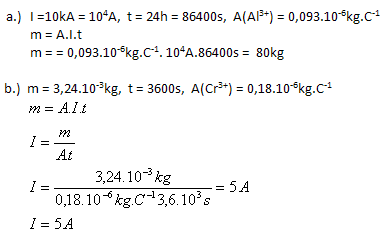
- a.) 80 kg of aluminum is deposited at the electrode.
- b.) Chromium is deposited at the electrode by a current of 5 A.
3.Determine the electrochemical equivalent of aluminum and copper
Solution:
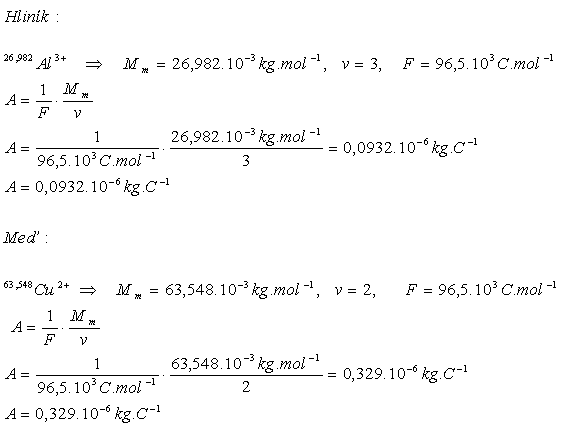
The electrochemical equivalents are A(Al)= 0.0932·10-6 kg·C-1 and A(Cu)=0.329·10-6 kg·C-1
4.An electric current of 1 A passes through an electrolyte of CuSO4. How many copper atoms are deposited on the cathode in 10 seconds? A(Cu) = 0.329·10-6 kg·C-1, NA = 6.022·1023 mol-1, Mm = 63.548·10-6 kg·mol-1
Solution:
Analysis:
I = 1 A, t = 10 s, A(Cu) = 0.329·10-6 kg·C-1, NA = 6.022·1023 mol-1, Mm = 63.548·10-6 kg·mol-1
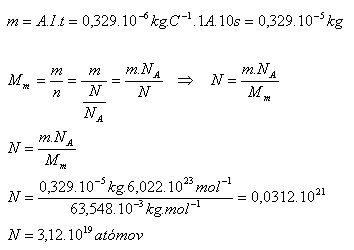
The number of copper atoms deposited on the cathode is N = 3.12·1019 atoms of copper.
5.A sphere with radius r = 5 cm is to be nickel-plated with a layer thickness h = 0.15 mm. How long should the sphere remain in the electrolyte at a current I = 1 A?
Solution:
Analysis:
r = 5 cm = 5·10-2 m, h = 0.15·10-3 m, I = 1 A, A(Ni) = 0.304·10-6 kg·C-1, ρ(Ni) = 8.8·103 kg·m-3
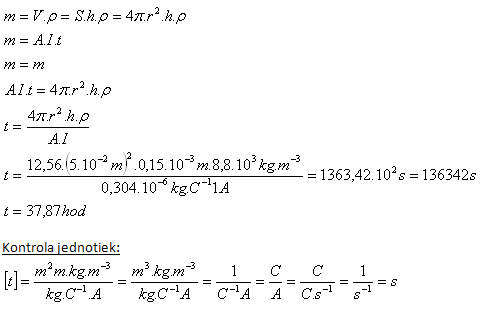
Nickel-plating the sphere takes about 38 hours.
6.Nickel-plating of a metal plate with surface area 100 cm2 took four hours at a current of 0.4 A. Calculate the thickness of the nickel layer formed on the plate!
Solution:
Analysis:
S = 100 cm2 = 10-2 m2, I = 0.4 A, t = 4 h = 14 400 s, v = 2, F = 96.5·103 C·mol-1,
Mm(Ni) = 58.7·10-3 kg·mol-1, ρ(Ni) = 8.9·103 kg·m-3
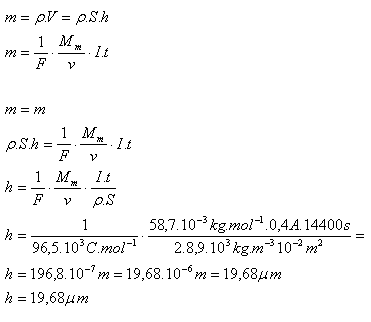
The thickness of the nickel layer is h = 19.68 μm.
7.How much energy do we need to obtain 1 g of copper by electrolysis of copper sulfate CuSO4, if the electrolysis runs at a voltage of 4 V?
Solution:
Analysis:
m = 1 g = 10-3 kg, U = 4 V, A(Cu) = 0.329·10-6 kg·C-1

During electrolysis we consume 12.2 kJ of energy.
8.Two electrolytic cells with solutions of AgNO3 and CuSO4 are connected in series. How much copper is deposited in the time during which 850 mg of silver is deposited?
Solution:
Analysis:
A(Ag) = 1.118·10-6 kg·C-1, A(Cu) = 0.329·10-6 kg·C-1, mAg = 850 mg. mCu = ?
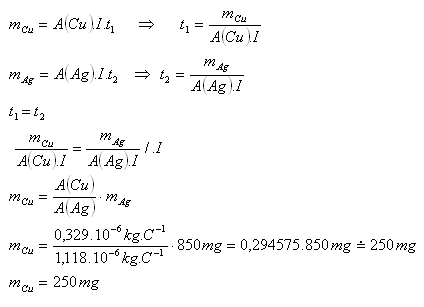
250 mg of copper is deposited.
9.What electric current passed through the electrolyte if the copper cathode weighed 35 g before the measurement and 39 g after the measurement, which lasted 40 minutes?
Solution:
Analysis:
Δm = 4 g = 4·10-3 kg, t = 40 min = 2400 s, A(Cu) = 0.329·10-6 kg·C-1
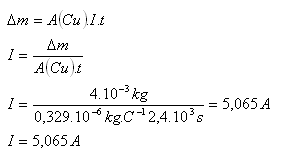
The current through the electrolyte was I = 5.065 A.
10.The decomposition voltage during electrolysis of sulfuric acid was 2.2 V. At a voltage of 3.5 V, a current of 2.8 A passed through the electrolyte. The electrodes were 4 cm apart and the cross-sectional area of the electrolytic conductor was 30 cm2. Determine the resistivity of the electrolyte!
Solution:
Analysis:
Ur = 2.2 V, U = 3.5 V, I = 2.8 A, S = 30·10-4 m2, l = 4 cm = 4·10-2 m, ρ = ?
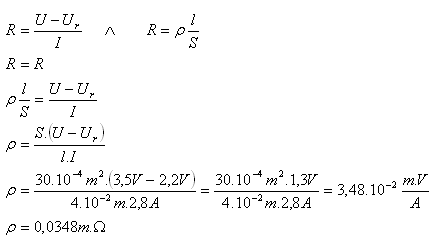
The resistivity of the electrolyte is ρ = 0.0348 m·Ω.
11.In what time will copper with a mass of 1.778 g be deposited from a CuSO4 solution by a current of 3 A?
Solution:

Copper will be deposited from the CuSO4 solution in about 30 minutes.
12.During the electrolysis of blue vitriol CuSO4, divalent copper with a mass of m = 9.504 g is deposited on the cathode in 2 hours. The ammeter showed a current IA = 4.1 A. Determine the error of the ammeter ΔI.
Solution:
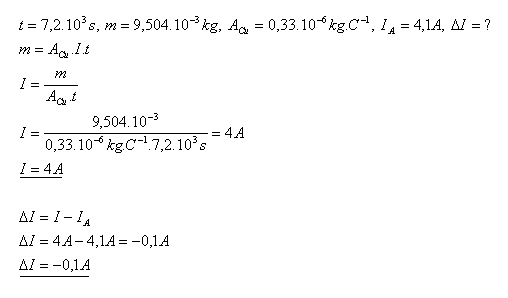
The error of the ammeter is ΔI = –0.1 A.
13.Two electrolytic vessels with AgNO3 and CuSO4 solutions are connected in series. Determine the mass of copper that will be deposited during the time in which 180 g of silver is deposited in the other vessel.
Solution:
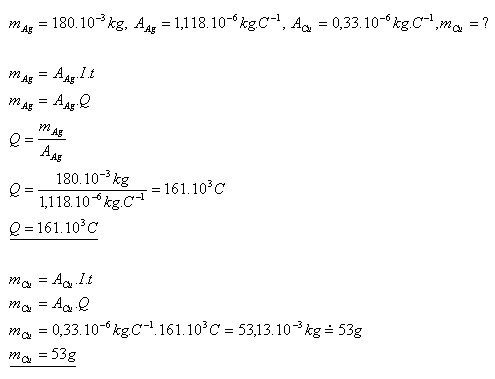
During electrolysis, about 53 grams of copper will be deposited.
14.During the electrolysis of ZnSO4, zinc with mass m = 2.45 g is deposited in 1 hour. Determine the electrical resistance of the solution if the voltage on the electrodes was U = 6 V.
Solution:
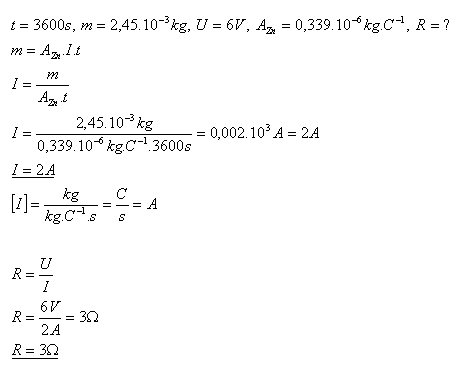
The electrical resistance of the solution is R = 3 Ω.
15.An object with a surface area S = 20 dm2 needs to be silver-plated with a layer thickness h = 0.2 mm. How long will the plating take if 1 dm2 of surface can be loaded with a current of I = 0.4 A?
Solution:
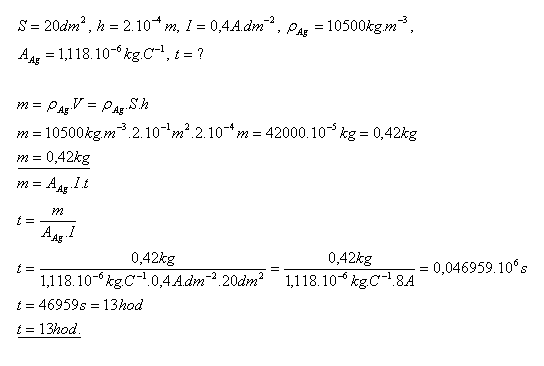
Plating the object will take about 13 hours.
16.How much energy is needed to obtain copper with a mass m = 1 g during the electrolysis of CuSO4, if the electrolysis was performed at a voltage U = 4 V?
Solution:
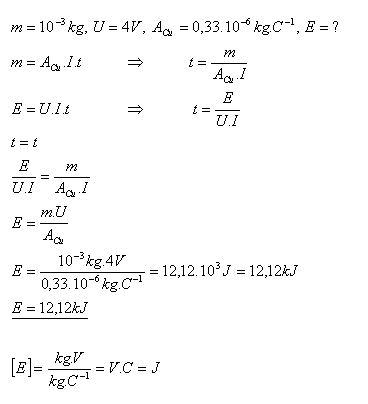
During the electrolysis of copper sulfate we need energy E = 12.12 kJ.
17.A current I = 1 A passes through a CuSO4 solution. How many copper atoms are deposited on the cathode in t = 1 s? (z = 2)
Solution:
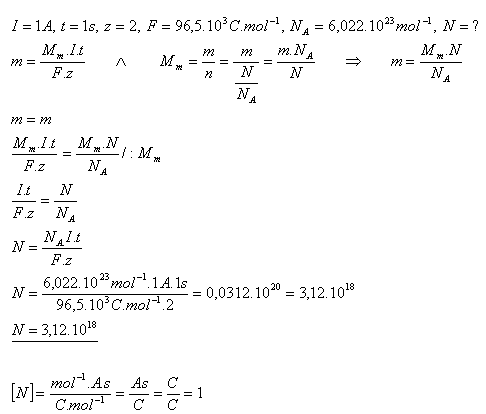
In 1 second, 3.12·1018 copper atoms are deposited on the cathode.
18.What is the electric charge of one silver ion that is deposited during the electrolysis of silver nitrate by a charge Q = 1 C?
Solution:
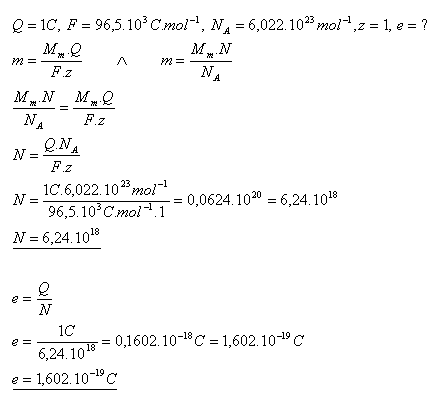
The charge of one silver ion is e = 1.602·10–19 C.
19.How much a.) silver b.) divalent copper will be deposited from their respective solutions if a charge Q = 96.5·106 C passes through them?
Solution:
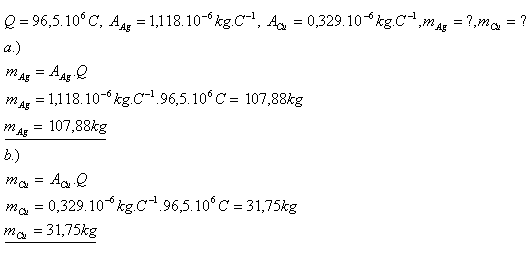
From the respective solutions, the charge Q will deposit 107.88 kg of silver and 31.75 kg of copper.
20.The accumulator was charged with a current I1 = 5 A for a time t1 = 6 hours. How long did it discharge if a steady current I2 = 0.05 A was drawn during discharging? The charge efficiency of the accumulator is η = 90%.
Solution:
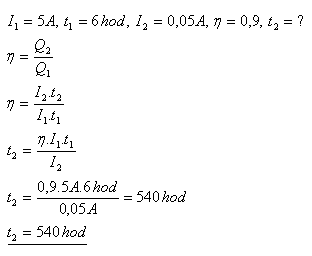
The accumulator discharged for 540 hours.